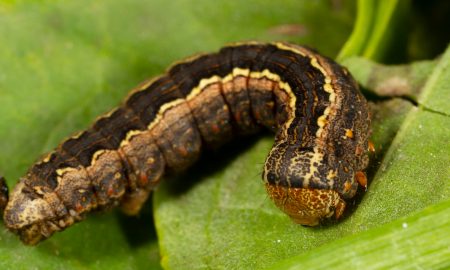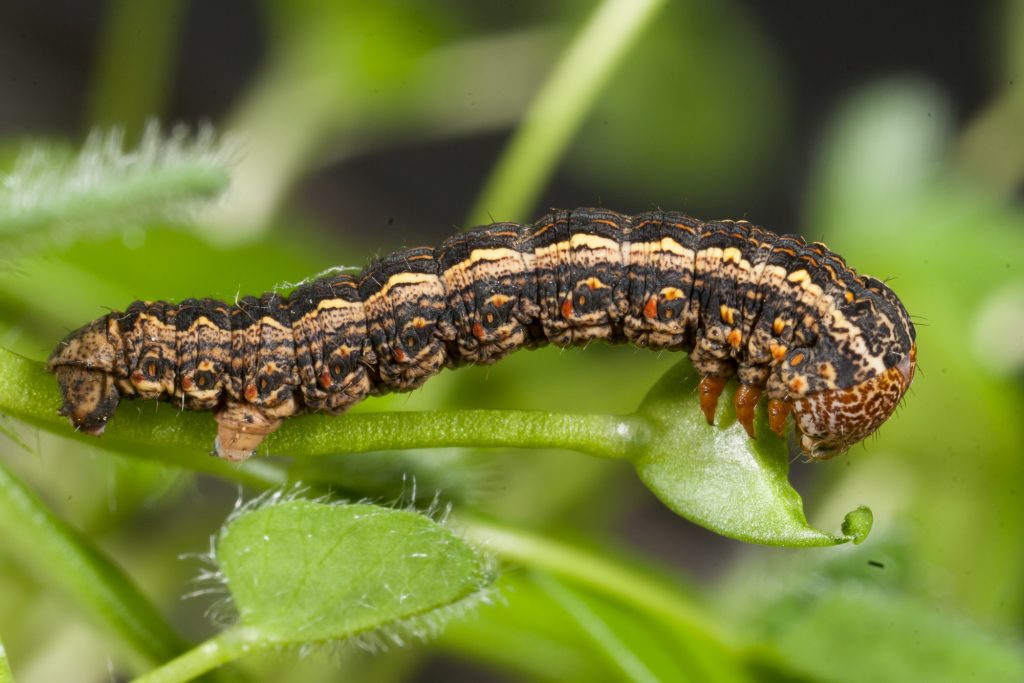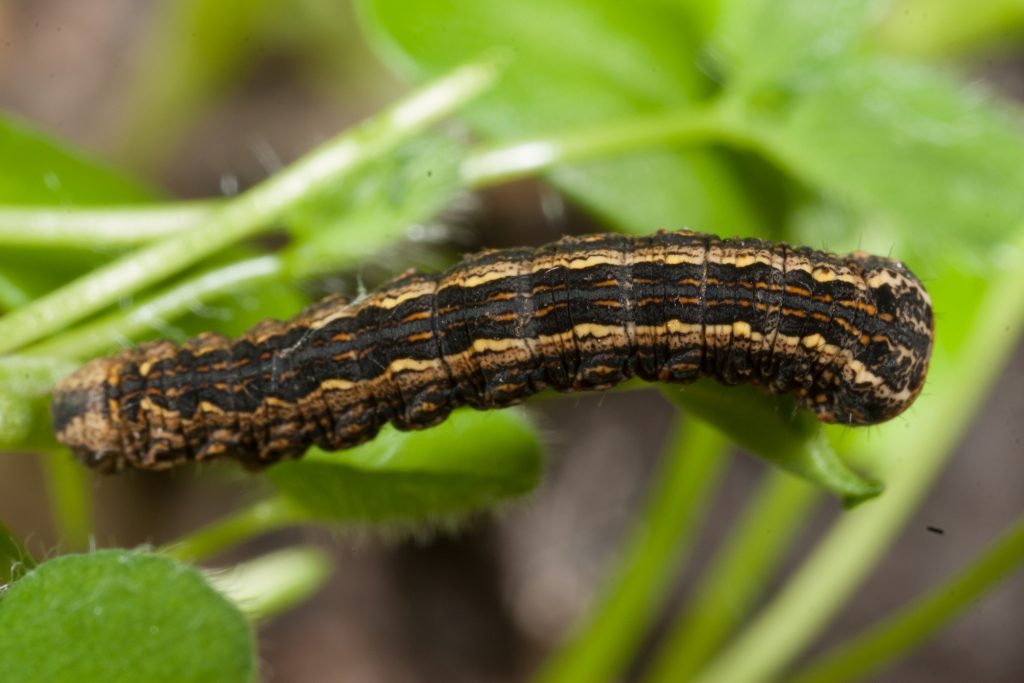Brown pasture looper
Ciampa arietaria

Photo by Andrew Weeks, Cesar Australia
Summary Top
Brown pasture loopers are relatively large, dark coloured native caterpillars with a characteristic looping motion. They can become an occasional pest on various crops. This generally occurs in autumn and winter when large caterpillars march from summer and autumn weeds onto newly emerged crop seedlings. Damage can be reduced by natural predators and controlling summer and autumn broadleaf weeds, particularly capeweed and stocksbill. If needed, there are several insecticides registered against brown pasture loopers, although spot spaying or perimeter spraying is usually all that is required.
Occurrence Top
An irregular minor pest that is native and widely distributed throughout Australia, except in the Northern Territory. They are more prevalent in high rainfall districts.
A native pest that is widely distributed throughout Australia and can become an occasional pest of broadleaf crop species.
Description Top
Brown pasture looper larvae are dark brown to grey with a distinctive wavy yellow line along the back either side of a conspicuous dark band. They have red colouration surrounding the breathing holes (spiracles) along the sides of the body, and can grow to 20–35 mm in length. They use their single pair of abdominal prolegs and one pair of anal prolegs to move using a series of back arches, which results in a characteristic looping motion.
Brown pasture looper larvae have two bright yellow, wavy lines running along the back.



Brown pasture looper larvae have two bright yellow, wavy lines running along the back.
Lifecycle Top
Brown pasture loopers have only one generation per year. Adult moths emerge after the autumn and remain active until about June. They typically lay eggs on plant leaves in early to mid autumn. The caterpillars that hatch from the eggs grow to full size in about two months. Once larvae reach full size in spring they pupate and remain dormant over summer. They emerge as moths in the following season.

Behaviour Top
Brown pasture loopers move with a looping action where the forelegs are extended to take grip then the back is arched to bring the hind legs up to just behind the fore legs. After defoliating broadleaf weeds, they can march into crops to cause seedling damage.
Similar to Top
Larvae are similar to native budworm and pasture day moth but only have one set of abdominal prolegs.
Crops attacked Top
Canola, lucerne and lupins, as well as broadleaved-weed component of pastures.

Damage Top
Larvae attack pastures, canola and some pulse crops, and are most damaging when caterpillars are greater than 20 mm long. They usually cause damage when they migrate from summer and autumn weeds onto newly emerged seedlings. Feeding damage to leaves and severe defoliation can occur.
Often movement of brown pasture looper from pasture to crops occurs when the broadleaf weeds on which they are feeding are killed with herbicide.

Monitor Top
Monitor crops and pastures soon after establishment. Brown pasture loopers are often prevalent around patches of capeweed and at the edge of crops. Older larvae can move in large numbers into crops from adjoining pastures.
Economic thresholds Top
There are no economic thresholds established for this pest.
Management options Top
Biological
Brown pasture looper eggs can be attacked by wasp caterpillar parasitoids.
Spined predatory shield bugs and glossy shield bugs attack young larvae.
Cultural
Control summer and autumn broadleaf weeds (in particular capeweed and storksbill (Erodium spp.) within paddocks and along fencelines.
Chemical
There are several insecticides registered against brown pasture loopers in pastures and various broadacre crops. Spot spraying or perimeter- spraying is usually all that is required as this pest often moves from weedy perimeters (eg. fencelines) into crops.
There are several insecticides registered against brown pasture loopers, however spot spaying or perimeter spraying is usually all that is required.
Acknowledgements Top
This article was compiled by Paul Umina (cesar) and Sandra Hangartner.
References/Further Reading Top
Bailey PT. 2007. Pests of field crops and pastures: Identification and Control. CSIRO Publishing, Melbourne, Australia.
Hopkins, D. 1987. Brown pasture looper. FactSheet 43/85. Department of Agriculture South Australia.
| Date | Version | Author(s) | Reviewed by |
|---|---|---|---|
| February 2015 | 1.0 | Sandra Hangartner and Garry McDonald (cesar) | Alana Governder (cesar) and Bill Kimber (SARDI) |
What are PestNotes?
PestNotes are information sheets developed through a collaboration between Cesar Australia and the South Australian Research and Development Institute (SARDI). Copyright: © All material published in PestNotes is copyright protected by Cesar Australia and SARDI and may not be reproduced in any form without written permission from both agencies.
Disclaimer
The material provided in PestNotes is based on the best available information at the time of publishing. No person should act on the basis of the contents of this publication without first obtaining independent, professional advice. PestNotes may identify products by proprietary or trade names to help readers identify particular products. We do not endorse or recommend the products of any manufacturer referred to. Other products may perform as well as or better than those specifically referred to. Cesar Australia and PIRSA will not be liable for any loss, damage, cost or expense incurred or arising by reason of any person using or relying on the information in this publication. Any research with unregistered pesticides or products referred to in PestNotes does not constitute a recommendation for that particular use.

